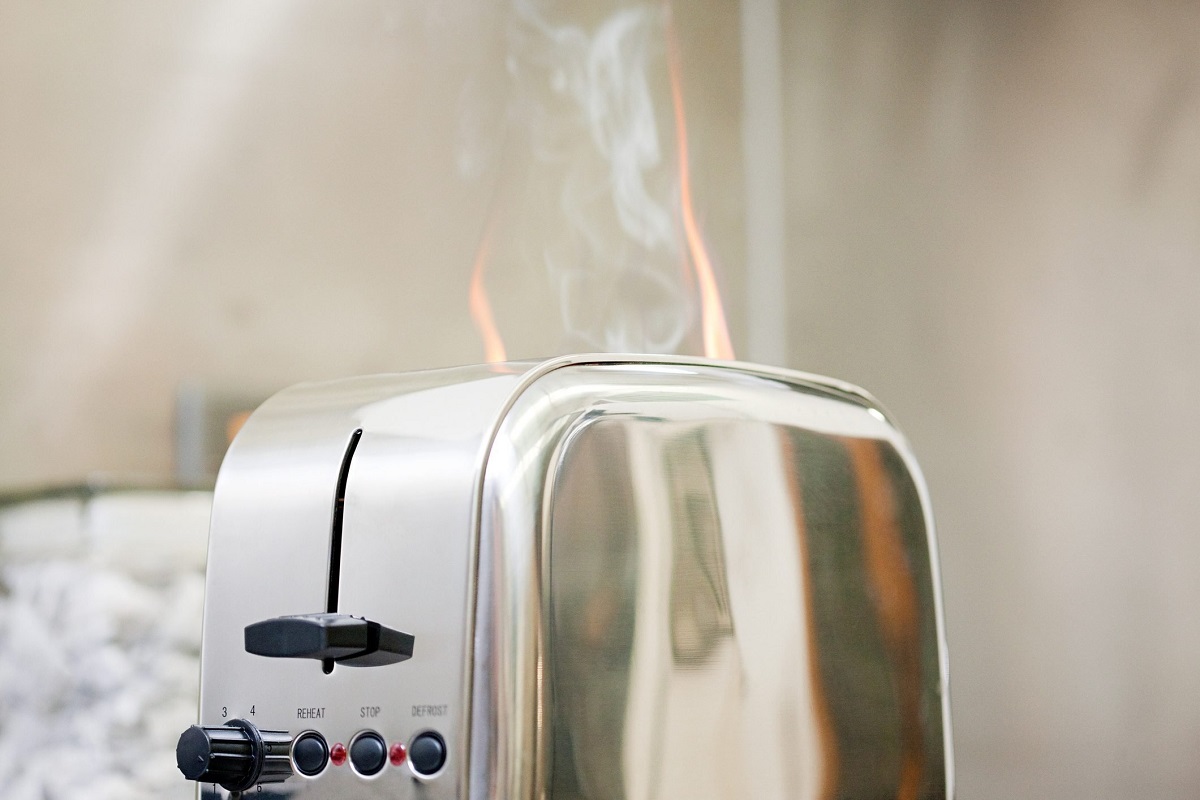Home>Articles>Which Best Explains Why An Electric Toaster Is Considered A Resistor


Articles
Which Best Explains Why An Electric Toaster Is Considered A Resistor
Modified: August 24, 2024
Learn why an electric toaster is considered a resistor with our informative articles. Find out how these appliances regulate electrical current, creating perfectly toasted breakfasts.
(Many of the links in this article redirect to a specific reviewed product. Your purchase of these products through affiliate links helps to generate commission for Storables.com, at no extra cost. Learn more)
Introduction
Welcome to the world of electrical appliances! From refrigerators to microwaves, we rely on a wide range of devices to make our lives more convenient. One such appliance that has become a staple in many kitchens is the electric toaster. But have you ever wondered why an electric toaster is considered a resistor?
In this article, we will explore the fascinating world of electrical resistance and uncover why an electric toaster can be classified as a resistor. We will delve into the working principle of an electric toaster and how it relates to the concept of resistance.
But first, let’s start with a brief definition of what a resistor is.
Key Takeaways:
- An electric toaster is considered a resistor due to its high-resistance heating elements, which efficiently convert electrical energy into thermal energy for perfectly toasted bread slices.
- The resistance of the heating elements in an electric toaster plays a crucial role in controlling the flow of current, ensuring consistent and controlled toasting without burning the bread slices.
Read more: Which Is The Best Electric Kettle
Definition of a Resistor
Before we can understand why an electric toaster is considered a resistor, let’s define what a resistor is. In simplest terms, a resistor is an electronic component that resists or opposes the flow of electric current passing through it.
Resistors are typically made of materials with high resistance properties, such as carbon or metal alloys, which impede the flow of electrons. They are often used in circuits to control the amount of current flowing through various components and to protect sensitive electronic devices from excessive voltage.
The resistance of a resistor is measured in ohms (Ω) and is determined by its physical properties, including length, cross-sectional area, and material composition. The higher the resistance, the more difficult it is for current to pass through the resistor.
Resistors are widely used in a variety of electronic devices, from simple household appliances like toasters to complex circuitry in computers and telecommunications equipment. Now, let’s explore the working principle of an electric toaster and how it relates to the concept of resistance.
Working Principle of an Electric Toaster
An electric toaster is a handy kitchen appliance used to toast bread slices, giving them a delicious golden brown color and a crispy texture. But how does it work?
The working principle of an electric toaster involves the transformation of electrical energy into thermal energy. When you insert bread slices into the toaster, they come into contact with a pair of metal filaments, known as heating elements, located inside the toaster’s cavity.
When you turn on the toaster by pressing the lever or switch, an electrical current flows through the heating elements. These elements are made of materials with high resistance, such as nichrome wire, which allows them to generate a significant amount of heat when an electric current passes through them.
The heat generated by the heating elements is then transferred to the bread slices through a process called conduction. As the electrical energy is converted into thermal energy, the temperature of the heating elements rises rapidly. This heat is directly transferred to the bread slices, causing them to undergo a chemical reaction known as the Maillard reaction.
During the Maillard reaction, the carbohydrates present in the bread slices undergo a complex series of chemical reactions that result in the browning and crisping of the toast. The heat also causes the moisture in the bread to evaporate, further enhancing the texture of the toast.
It’s important to note that the heat generated by the heating elements must be carefully controlled to prevent the bread from burning. Modern toasters are equipped with a thermostat or a timer mechanism that regulates the amount of heat and the duration of toasting, ensuring consistent and perfectly toasted bread slices.
Now that we understand the working principle of an electric toaster, let’s explore the relationship between resistance and the operation of the toaster.
An electric toaster is considered a resistor because it converts electrical energy into heat energy, creating resistance to the flow of current. This resistance allows the toaster to generate heat and toast bread.
Ohm’s Law and Resistance
To understand why an electric toaster is considered a resistor, we need to delve into Ohm’s Law and the concept of resistance. Ohm’s Law, formulated by the German physicist Georg Simon Ohm, states that the current flowing through a conductor is directly proportional to the voltage applied across it and inversely proportional to its resistance.
The mathematical formula for Ohm’s Law is:
V = I * R
Where:
- V: Voltage (measured in volts)
- I: Current (measured in amperes)
- R: Resistance (measured in ohms)
According to Ohm’s Law, the resistance of a conductor determines the amount of current that will flow through it when a voltage is applied. The higher the resistance, the lower the current will be for a given voltage.
This brings us back to the electric toaster. The heating elements in an electric toaster are made of materials with high resistance, such as nichrome wire. When the toaster is turned on, a voltage is applied across the heating elements, and an electric current flows through them.
The high resistance of the heating elements restricts the flow of current, causing them to heat up. This is because the electrical energy passing through the heating elements encounters resistance and is converted into heat energy. The heat generated is then transferred to the bread slices, as explained earlier.
Therefore, the high resistance of the heating elements in an electric toaster directly contributes to the toasting process. It allows for the controlled conversion of electrical energy into thermal energy, ensuring that the bread slices are evenly toasted without getting burnt.
Now that we understand how an electric toaster operates as a resistor, let’s summarize our findings.
Electric Toaster as a Resistor
After exploring the working principle of an electric toaster and the concept of resistance, it is clear that an electric toaster can indeed be classified as a resistor.
An electric toaster contains heating elements, typically made of materials with high resistance properties, such as nichrome wire. These heating elements act as resistors by impeding the flow of electrical current passing through them, resulting in the generation of heat.
The heat generated by the heating elements is transferred to the bread slices, toasting them to perfection. The resistance of the heating elements plays a crucial role in controlling the amount of current flowing and, consequently, the amount of heat generated. This allows for consistent and controlled toasting, preventing the bread slices from burning.
It is important to note that an electric toaster is not just a passive resistor but also incorporates other electrical components such as thermostats or timers to regulate the toasting process. These components help maintain a specific temperature or duration of toasting, contributing to the overall functionality of the toaster.
Moreover, the use of high-resistance materials in the heating elements of an electric toaster ensures that the majority of the electrical energy is converted into thermal energy. This efficient conversion minimizes energy wastage and maximizes the toasting efficiency of the appliance.
In summary, an electric toaster can be considered a resistor due to the presence of heating elements made of high-resistance materials. These elements impede the flow of electrical current, generate heat, and enable the toasting process. The resistance of the heating elements contributes to a controlled and efficient conversion of electrical energy into thermal energy, resulting in deliciously toasted bread slices.
Now that we have uncovered the reasons why an electric toaster is considered a resistor, let’s wrap up our discussion.
Read more: Which Is The Best Electric Toothbrush
Conclusion
In conclusion, an electric toaster can be classified as a resistor due to the presence of heating elements made of materials with high resistance properties. The resistance of these elements impedes the flow of electrical current and generates heat, which is then transferred to the bread slices, resulting in evenly toasted toast.
The working principle of an electric toaster involves the transformation of electrical energy into thermal energy, achieved through the controlled resistance of the heating elements. The high resistance of these elements allows for the efficient conversion of electrical energy into heat energy, ensuring that the bread slices are toasted to perfection without burning.
Ohm’s Law, which states the relationship between current, voltage, and resistance, helps us understand why the heating elements in an electric toaster act as resistors. The resistance of the heating elements determines the amount of current that flows through them, directly influencing the amount of heat generated.
Furthermore, an electric toaster is not just a passive resistor but also incorporates additional electrical components such as thermostats or timers to regulate the toasting process. These components ensure consistent and controlled toasting, enhancing the functionality of the toaster.
In summary, the concept of resistance, along with Ohm’s Law, helps us understand why an electric toaster is classified as a resistor. The high-resistance heating elements in the toaster play a crucial role in generating heat and achieving the desired level of toasting. By efficiently converting electrical energy into thermal energy, an electric toaster provides us with deliciously toasted bread slices, making it an essential appliance in many kitchens around the world.
So, the next time you enjoy a crispy and perfectly toasted slice of bread, remember the role that the electric toaster, functioning as a resistor, plays in creating that delightful morning treat!
Curious about the latest trends in kitchen gadgets? Our upcoming article on fabulous electric toasters for next year will guide you through the top picks to brighten your morning routine. Also, if you've ever wondered about the flow of electricity in your home devices, don't miss our insightful piece on electrical resistance in different cords. Both articles promise to shed light on intriguing aspects of everyday technology.
Frequently Asked Questions about Which Best Explains Why An Electric Toaster Is Considered A Resistor
Was this page helpful?
At Storables.com, we guarantee accurate and reliable information. Our content, validated by Expert Board Contributors, is crafted following stringent Editorial Policies. We're committed to providing you with well-researched, expert-backed insights for all your informational needs.















0 thoughts on “Which Best Explains Why An Electric Toaster Is Considered A Resistor”